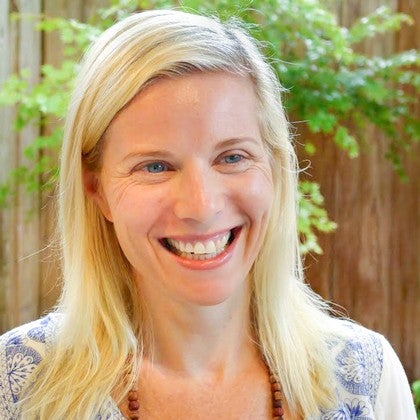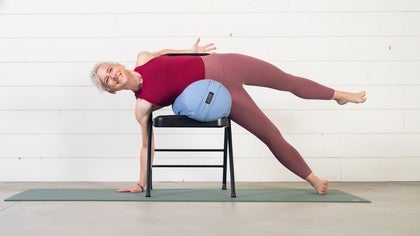
The Bones of Yoga
It’s been 24 years of practicing yoga asana and I’ve never gotten my heels to the floor in a down dog. At least, not unassisted.
Sure, I’ve had glorious moments when a teacher pressed on the back of my pelvis and I took in the view of my heels planted solidly on the floor. But as soon as the teacher’s hands left my low back, my heels were once again buoyant.
This really bothered me back in my early days of practicing asana. Heels on the floor in down-dog is like a rite of passage. Surely it was something I needed to achieve in order to be “good” at yoga.
And then I saw Paul Grilley’s Anatomy For Yoga. My perspective was forever changed.
I had always thought that it was my efforts that would develop the poses for me; my devotion to practicing on the yoga mat. I figured that if the person on the mat beside me could do a pose and I couldn’t, they were simply “better” at yoga - more experienced and therefore more advanced.
But Grilley explained that the impediments we experience in some poses could be due not to the tightness of our muscles or the amount of time we dedicate to practicing the asanas, but instead, we might be hindered in poses based on something far less malleable: our bone structure.
Sure, some of us who can’t get our heels on the floor in down dog might just be tight in the calves, hamstrings, or muscles of the low back, but for others of us, it’s not the tension of our muscles keeping the heels off the floor, but the compression of bones and soft tissue at the front of the ankle.
I had never considered this until I saw Grilley’s lecture, but if I was asked to point to the place that seemed to be stopping my heels from lowering all the way to the floor in down dog – where I feel the sensation of a hindrance - I would have pointed to the front of my ankle.
It’s worth noting that when teachers pressed on my pelvis in down dog, I never felt an increased stretch in the backs of my legs or even my low back. It certainly wasn’t muscular tension keeping me from planting my heels.
All this made me wonder, if bones – and not just muscles - were truly to be considered when practicing yoga, then where else in my asana practice were bones limiting me?
And as a teacher, I had to consider not just my own practice but the practices of my students. Was it possible that some of the poses I had promised my students they would eventually achieve were actually not attainable goals or even safe for certain students?
Grilley demonstrated in his video with actual yogis that some people might not have the humerus (upper arm bone) length to allow for proper head and neck placement in a headstand.
In other students, he explained that the way the femur was situated in the pelvis might be deciding the extent of their external or internal femoral rotation. Perhaps certain students with limited external rotation of the femur weren’t built for lotus pose. These yogis might never sit in lotus pose comfortably.
I was shocked. Every teacher up until that point had told me that, eventually, I would get there.
Since watching that video in 2005, I have since studied extensively with Paul and Suzee Grilley and I’ve seen first-hand how our unique bone structure plays a leading role in the capabilities of our asana practice.
Grilley has displayed that some students don’t have the range of humeral flexion available to achieve a solid upper-body tripod-base in pincha mayurasana. Furthermore, this limited range of humeral flexion might make a student’s shoulders look different in a down dog. This makes us wonder if perhaps there is not a picture-perfect down dog we should all be striving for.
Or, considering backbends, if a student doesn’t have the range of humeral flexion to accommodate adequate extension of the thoracic spine, this limitation could potentially cause more strain on the student’s lumbar spine (low back).
Admittedly, with all this to consider, yoga gets far more confusing. We can’t just look at an image and say we have achieved the pose when it looks “picture-perfect”. We have to feel the pose for ourselves and chart our own unique course.
Further muddling the situation is that compression doesn’t hurt; it just stops you. The compression we may feel in our poses is often unobtrusive. This “springy” or “bouncy” sensation that often accompanies a compression point doesn’t have the menacing or perilous “warning” that muscle tautness has. Because of this harmless sensation, we are often given the falsifying hope that we can just push through and eventually achieve a pose if we just keep practicing.
Of course, we are all hesitant to strain or tear a muscle in a pose and this, in turn, makes us more cautious with our muscle tautness. But should we also be paying attention in our poses to the unassuming compression sensations of bone and soft tissue?
Bernie Clark, a student-turned-colleague of Paul Grilley’s says we should. If you are looking for extensive research on the subject of skeletal variation, Clark’s books are mind-expanding tools.
But wait - isn’t this a bummer? That some poses are just not achievable for certain bodies?
Not at all!
The good news is that the competitiveness of yoga evaporates with this new perspective. With this understanding of skeletal variation and compression, an asana practice takes a more intimate and exploratory course filled with curiosity and a desire to understand the function of poses.
There is no need to compare your yoga to others - to mimic or compete - because your yoga is supposed to look different from others. Your version of the poses should be unique – because you are unique!
We cannot get lost in what a pose looks like; we must be more absorbed in what our yoga feels like. And the beauty of this tactic is that feeling our poses to achieve their functionality calms the mind much more than striving to make the pose look a certain way.
Yoga becomes a personal quest and not just choreography. The goal is to discover what works for your body and not someone else’s body.
What a journey that is: focusing on the internal and not the external of an asana practice.
Considering the bones in our yoga practices grounds us. It brings us back from any lofty pursuits we may have had for our bodies in regards to asana and teaches us that we will always experience limiting factors, but working with what we have and celebrating our uniqueness are pursuits most likely to offer us the true peace of yoga.
Comments
You need to be a subscriber to post a comment.
Please Log In or Create an Account to start your free trial.













